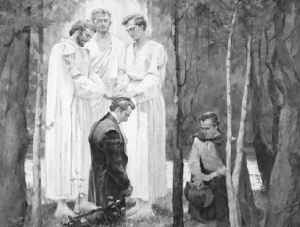
Now compare that to this post from John Nilsson back from my Mormon Matters days. I found it an interesting example of how difficult it is for us to remove our biases when dealing with religious history. (Or probably with any sort of history we care about.)
When I turned this rudimentary training [in history] on the sources describing the stories above [about angelic ordination of the priesthood], I found the records to be vague and contradictory, more so than in the case of Joseph’s different accounts of the First Vision. This is partly because Joseph had a co-participant, Oliver Cowdery, who left his own account of these experiences, and that many other early Church members wrote as if they did not hear of these ordinations until 1834 or 1835. Cowdery’s account is especially interesting, as he mentions only one occasion of priesthood bestowal, only one priesthood, only one angel visiting, and declines to name the angel as either John the Baptist or Peter, James, and John. (Note that the Church has added an “s” to “holy angel(s) in the link to the Oliver Cowdery account above to soften the ambiguity, under the guise of correcting “spelling, grammar, and punctuation”.
Very little of the above is factually correct. The problem is that there are no non-theory-laden observations. (I discussed this important part of Popperian epistemology here. This is why I find it humorous when a person insists they are a free thinking skeptic that ‘goes where the evidence leads.’ A true free thinking skeptic, if any exist, would never say such a thing.)
I agree that Oliver only wrote about one angel when mentioning the Aaronic Priesthood. And I agree that he mentions only one angel – who he names as “Peter”, by the way, in other sources – when he talks about receiving the Melchezidek priesthood. I do not, like this author, assume that the two incidents are one and the same. And why should I? Oliver claimed they were two incidents with two priesthoods:
I was present with Joseph when an holy angel from God came down from heaven and conferred on us, or restored, the lesser or Aaronic Priesthood, and said to us, at the same time, that it should remain upon the earth while the earth stands. I was also present with Joseph when the higher or Melchizedek Priesthood was conferred by the holy angel from on high. This Priesthood, we then conferred on each other by the will and commandment of God. (link)
The issue that this all seems to twist on is that fact that this quote is sometimes quoted with “angel” as a plural. (See here for example. Note that both the singular and plural versions are both available on the Church’s website. So much for conspiracy theories.)
The theory being advanced is that since Oliver and Joseph couldn’t agree on how many angels appeared and did the ordination, that it must just be a vision of the mind. The ‘conspiracy theory’ that the Church then added an “s” later to cover this up is used to support this narrative.
But that’s an awful lot of data he feels he’s pulled out of one letter, isn’t it? Way more than seems rationally or scholarly justified, to me.
I think part of the problem is that when we speak of Oliver receiving his priesthood ordination, modernly we speak of “Peter, James, and John” doing it, thanks to the missionary discussions and certain famous paintings of the event. But notice that this isn’t how we normally speak of Priesthood ordinations. Normally we only think of the person that did the speaking as doing the ordination. (See the post “Do you remember who ordained you to the priesthood?” as proof of this.) The rest in the circle are ‘helpers’ not ‘ordainers’ in our minds. Why would we expect Oliver to be different from us in this regard?
So the difference that the author of the post is highlighting actually has two possible explanations. One is that the whole thing was just a vision, not resurrected beings, and that is why there is a “discrepancy”. (Or, if you prefer, we can call this theory the ‘it’s all in their mind’ or ‘fiction theory’.) Thus his question about priesthood ordinations without the laying on of hands.
The other theory is that Oliver says Peter ordained him because in fact he did. Physically. In this theory Oliver “left out” the other two angels in the quote above because they were helpers, not the actual ordainer. So there is no discrepancy at all.
Take your pick.
My point is that you’ll pick based on your pre-existing beliefs and you’ll have a hard time believing that you aren’t being prejudiced by those pre-existing beliefs.
Further, this is a real life example of an informationless narrative fallacy. The data supports either point of view yet praciting-but-not-believing Mormons act as if it represents a problem for the Church. But since their only evidence for their narrative is the same evidence that can be used against the narrative, in fact they have no evidence at all.
The real truth is that it is a narrative fallacy that plays off our natural skepticism of all things supernatural. Pretend, for a moment, that Oliver had claimed that Father Smith ordained him and Joseph Smith claimed it was Father Smith, Mother Smith, and Alvin Smith. No respectable historian would ever think to claim that the two stories are at odds with each other and therefore must have been in their minds. It’s only the fact that we’re talking about angels that causes us to perceive a problem in the first place.